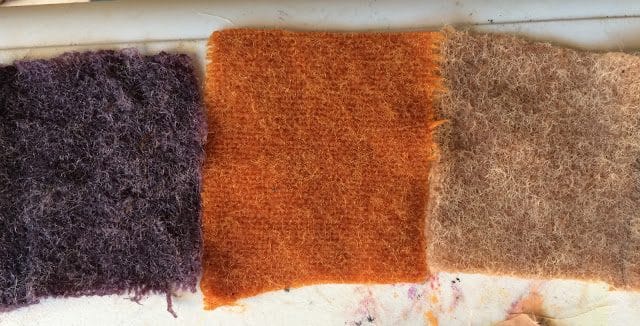Would you believe that this is the colour you get from purple carrots, brown onion skins and avocado seeds on natural fibre fabrics! I love this so much – so easy, so cheap, non-toxic, no waste!
 |
A natural-coloured old wool blanket dyed with vegetables. These colours are fast.
Purple carrot = purple (of course). Onion skin = orange. Avocado seed = light brown. |
 |
Brown onion skins boiled for 1 hour in water.
The fabric is then submerged into this pot and boiled for another hour.
The samples above were only in for 15 minutes.
While the colour does not wash out it fades over time – then you can simply refresh the colour with another soak. |
 |
| Boiling up the purple carrot and avocado colour pots.
|
Last weekend I took Maia and Hugh to do a family-friendly natural dye workshop with Alieta, Leeza and Olin from the Forest Art Collective in Maleny. It revolutionised my thinking about what we can do about making non-toxic clothing – I’m totally hooked!
 |
| The learning circle. |
 |
| Fabulous creative science. Many young children loved this workshop.
|
I really cannot believe how simple and effective the techniques are and how colouring fabrics this way creates only a tiny bit of compostable waste – the onion skins, boiled carrots and avocado seeds.
 |
| The waste from the botanical print dying process – compostable leaves, re-usable twine, and reusable metal scraps. |
During the workshop we also experimented with botanical prints using leaves on natural fabrics. Here are the sample strips I did. You can see silky oak, eucalyptus, cinerea, bleeding heart – on silk, cotton, wool and paper. I can’t wait to keep experimenting and making my own hand-dyed organic clothing. Thankfully there’s a great shop in my local town where I can source un-dyed organic fabrics.
 |
| My first go at creating natural botanical prints using natural fabrics and paper, leaves, water, twine and an iron rod. |
 |
| I moistened the wool strip. (NB: you can see the original colour of the wool here that was used in the carrot, onion and avocado dyes) |
 |
| Roll the leaves tightly in with the wool onto a rusty iron rod. The iron helps to fix the plant print to the fabric and give the black colour. |
 |
Bind tightly with twine to hold it all in place when it is boiled.
 |
| Wool with |
|
 |
| Create whatever patterns you like – here I used cinerea and eucalypt
|
 |
| I added 4 different leaf arrangements on my rod. It is also possible to have a large piece of fabric folded over to create leaf patterned prints. |
 |
| Boil the wrapped iron rods in a pot of water for 1 hour. |
 |
| I unravelled my stick as soon as it came out of the pot – so curious to see what had happened. If I’d had the patience to leave it rolled and moist for 3 weeks, all the colours would be far more intense. |
 |
| We used iron at the workshop, but by wrapping and boiling with different rods you can get different effects. When you boil up in a stainless steel or aluminium pot, iron = black, copper = blueish tinge, wood = neutral. The metals also fix the colours. |















It's fascinating Morag.
Thank you for sharing.
Your post had me pulling out the little box of silk fabric that I dyed at a workshop at Northey Street more than a year ago. It's been ages since I looked at them and thought what I would make. I loved opening out the fabric once the process was complete and seeing what resulted from the plants we had picked from the garden of the city farm. My favourite result was the deep plum-red burst made by the small black "fruits" of ceylon spinach. Thanks so much for sharing and helping to remember my little box of dyed treasure. Meg
really inspiring – thanks!
Very inspirational post, thank you for sharing!